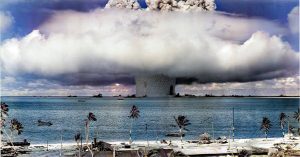Just three months after the atomic ruins of Hiroshima and Nagasaki had been burned into Japan’s landscape, U.S. military and political leaders began planning a series of atomic weapons tests in order to study the effects of the bomb on naval vessels. With World War II over and a new era of Pacific control ahead, the United States selected Bikini and Enewetak Atolls in the northern Marshall Islands, part of what it called the Pacific Proving Grounds, as the site of 67 nuclear weapons tests. These tests played a key role in setting the stage for global politics and power struggles for the first 75 years of the atomic age.
On July 1, 1946, Joint Task Force One launched Operation Crossroads “Test A” (Able) when, at exactly 34 seconds past 9 a.m., a B-29 Superfortress dropped a 23-kiloton plutonium bomb (nearly identical to the “Fat Man” bomb that destroyed Nagasaki) over Bikini Atoll. The bomb exploded 520 feet above sea level, where 242 naval vessels floated in the eastern lagoon as targets. Operation Crossroads continued on July 25 with “Test B” (Baker), the world’s first underwater nuclear detonation. A third test, Charlie, was cancelled due to radiation concerns. As described in the military’s official report, whether detonated in the air or under water, the atomic bomb’s end result would be “death and destruction on an enormous scale.”
Subsequent test names included Nutmeg, Walnut, Maple, and Rose. More than a dozen had American Indian tribal names – Apache, Navajo, and Dakota – while others were prosaically called Mike, George, or simply Dog. Early tests were conducted sporadically – three in 1948, four in 1951, two in 1952, six in 1954 – but in the final two years, the U.S. sharply accelerated the pace. Between May 1956 and August 1958, the U.S. detonated 50 nuclear and thermonuclear bombs, often just a few days apart. On seven occasions, tests were carried out on consecutive days and seven times atomic bombs were detonated twice in a single day.
The tests were of greatest consequence to the people whose homeland was selected for the detonations, which proved to be catastrophic to the health, environment, and well-being of the Marshallese. The 67 tests had a total yield of 108 megatons – the equivalent of 1.6 Hiroshima-sized bombs being detonated every day for a dozen years. Testing irrevocably disrupted life in the Marshall Islands, introducing generations of dislocation, disease, and premature death. Traditional practices were punctured, whole islands were vaporized, and a giant poison-filled concrete dome was left at the edge of a plutonium-spiked lagoon.
Beginning with 167 Bikini Islanders who were told that the abandonment of their islands was “for the good of mankind and to end all wars,” followed by residents of neighboring atolls, entire communities were forced to leave their ancestral homes only to be returned later, then relocated again and again, causing profound impacts that continue today.
Seventy-five years after Operation Crossroads, a new generation of Marshallese is demonstrating resilience, determination, and vision, proving themselves to be global leaders as they fight for nuclear and climate justice, determined to save their islands and their way of life.

































